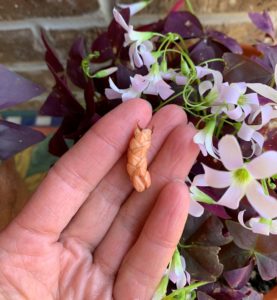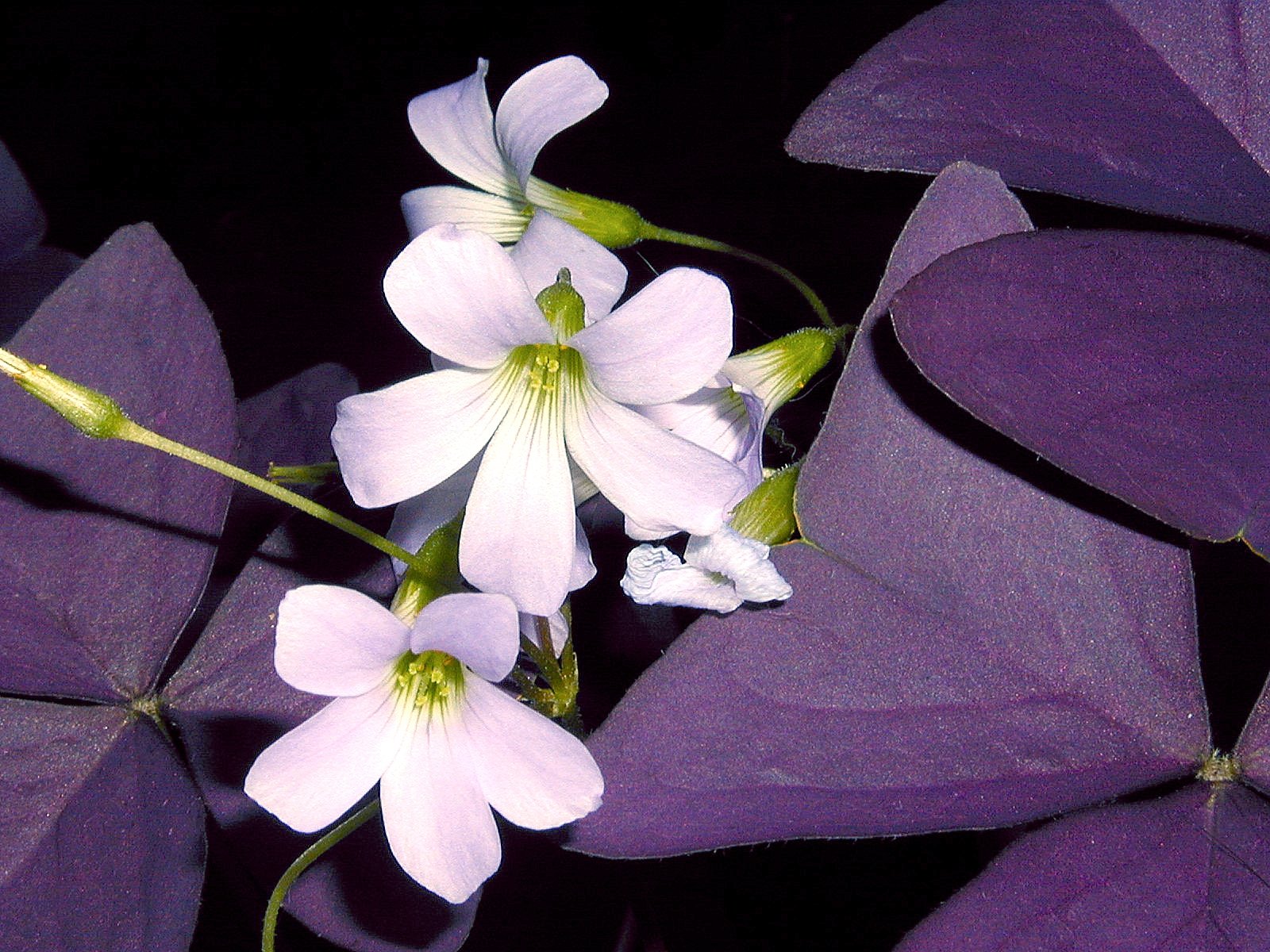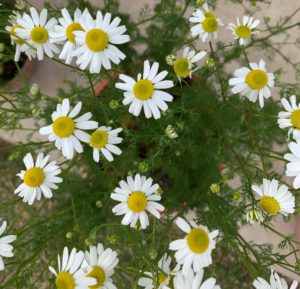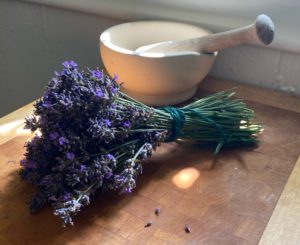Oxalis triangularis, also known as the purple shamrock plant because of its purple shamrock-shaped, trifoliate leaves,[1] is an ornamental plant that is easily grown indoors and outdoors. Even though it is called a shamrock plant, it is not related to shamrock clover and for that reason, it is also known as the false shamrock plant. Instead, oxalis are members of the wood sorrel family.
There are over 500 varieties of oxalis in the world, showcasing leaves that are green, silver, purple, or variegated, depending on the variety. The dainty flowers are white, pink, yellow, rose, or lavender. Some varieties may even have striped or bi-colored flowers.

Oxalis leaves fold at night due to a process called nyctinasty in which the plant responds to changes in light and temperature at night or on cloudy days. This folding of the leaves prompts some to refer to the oxalis as “butterfly shamrocks” because the leaves mimic the opening and closing of a butterfly’s wings. And while we are discussing nicknames, some refer to the oxalis triangularis as the love plant because the leaves appear heart-shaped.
Not all oxalis varieties are embraced by plant lovers. Some varieties, like the buttercup oxalis (Oxalis pes-caprae), the yellow wood sorrel (Oxalis stricta), and the creeping wood sorrel (Oxalis corniculate), are invasive and therefore considered weeds.
In this post, we will learn how to grow the purple shamrock plant both indoors and outdoors.
How to Grow Oxalis Outdoors
Oxalis triangularis is a mounding plant that is grown from corms, which, like bulbs, tubers, and rhizomes, are swollen stems that remain under the soil and serve as the plant’s nutrient storehouse. If you have a larger corm, you can gently break it apart and plant the smaller individual pieces.

Once the threat of frost has passed, plant corms 1 to 2 inches deep in a well-draining potting mix. Oxalis prefer slightly acidic soil, but it will adapt to less than perfect pH conditions. Place the narrow or more pointed end of the corms facing up, and the rounded, broader end facing down. If planting in a container or raised bed, space corms about 2 to 4 inches apart. Oxalises do not mind being a little crowded and grow well even if they are somewhat pot-bound.
Water the corms, making sure the soil is moist, but not soggy. Sprouts should appear in about two to three weeks and blooms will follow in a few months.
The purple shamrock does not require as much sun as other varieties of oxalis, but several hours of full sun each day will help its leaves maintain their deep purple color. Too much sun, however, especially during the hottest part of the day, could cause leaf burn. So, if growing in an area that has more sun exposure, be sure the plant has some shade from the afternoon sun. Conversely, if you have a mostly shady area that needs a touch of color, oxalis triangularis should do just fine although the leaves may lose some of their deep color.
Water and Fertilizer
Water oxalis when the top inch of soil feels dry to the touch. Note, however, that if the plant is wilting, it may not be getting enough water. Be careful not to overwater the plant as soggy soil can cause the corms to rot.
These low-maintenance beauties do not require much fertilizer. A balanced fertilizer once or twice a month during the growing season works well.
The purple shamrock will bloom as long as the weather in your area permits. The majority of the blooms will occur in the spring and fall when temperatures are cooler. I live in the South, which means that mine bloom most of the year if I protect them from the scorching heat of summer and cover them during a short frost or freeze. The exception is during the plant’s dormancy period when it stops producing new blooms.

Dormancy
Oxalis triangularis will go dormant during the summer for a period of a few weeks to a few months. So do not worry if it loses at least some of its leaves and stops blooming. During this time, cut off the spent leaves and water less frequently. You will need to stop fertilizing the plant as well. When you see new growth, you will know that plant has come out of dormancy, and you can commence caring for it once again.
This article contains affiliate links. If you make a purchase using one of these links, I will receive a very small commission at no additional cost to you, and it will help me maintain this website. Rest assured, I only recommend products I actually like!
Overwintering Your Oxalis
Oxalises are perennials that are generally cold hardy in zone 6 and warmer. For those who live in colder climates, it acts more like an annual. If you live in a cooler zone and want to overwinter it, dig up the plant and the corms before the first frost and plant them indoors. It may take a bit for it to adjust to its new surroundings. When spring arrives, replant them outdoors. If, on the other hand, you do not have the space or the desire to grow them indoors, you can dig up the corms, gently remove any excess dirt, and, once the leaves dry up, transfer them to a container filled with either sphagnum moss or peat moss. Store them in a cool, dark room until spring.
How to Grow Purple Shamrock Indoors
Oxalises can also be successfully grown indoors. Plant them in a container with good drainage and place them in a window that gets bright, but indirect light. You may need to rotate the plant periodically as it will grow in the direction of the sun. If the area where the plant is located gets too warm, 75°F (24°C) or more, you may need to relocate the plant to a cooler window.

Keep the soil evenly moist but not soggy, watering when the top inch of soil feels dry to the touch. Use a liquid balanced fertilizer once or twice a month during the growing season. When the plant goes dormant (it will stop blooming and lose at least some of its leaves), water it less frequently and discontinue fertilizing. Trim the dead leaves off at the soil level. When new growth appears, resume its normal water and fertilizer schedule. Some advocate for relocating the plant to a cool dark space during dormancy but this may not always be possible or necessary.
How to Propagate Purple Shamrock
Purple shamrock plants are easy to propagate. Simply divide the plant into half or thirds, making sure each section has roots and corms. Plant each section in fresh potting mix and care for it as usual. A good time to divide the plant is during its dormancy phase.
Another way to propagate the plant is by pulling up one or more of the leaf stems just below the surface of the soil. A small section called the cusp should still be attached to the end of the stem. Or, even better, if a portion of the corm is still attached. Plant the leaf stems in a container filled with fresh potting mix. Water it and place it in a sunny spot that does not get too hot. Keep the soil moist and in a few weeks, you should see new growth, a sign that the propagation was successful. Some prefer to root the leaf stems in water before planting them in potting mix.

Is Oxalis Triangularis Toxic?
Is oxalis triangularis toxic to animals? Technically yes. All members of the genus produce oxalic acid, a caustic chemical. In oxalises, however, the toxin is only harmful when large quantities have been ingested. Thankfully, the leaves taste bitter, so most dogs and cats are not interested in eating them. Interestingly, some people who do not mind the bitter taste, use a few of the purple leaves to garnish a salad, just like you would certain flowers, like nasturtiums, for example. But uses caution as eating too many leaves may upset your stomach or cause other problems.
Pests and Diseases
Purple shamrocks, like marigolds and other plants, may become a host plant for aphids, whiteflies, mealybugs, spider mites, slugs, and snails. You can learn more about each of these pests, including how to get rid of them organically, by following the links.
As for diseases, powdery mildew, rust, and root rot may pose a threat. Powdery mildew and rust can be treated organically. Root rot can be avoided by being careful not to overwater the plant.
Oxalis triangularis, or purple shamrock, is an easy plant to grow, and one that looks beautiful as a groundcover, border plant, in hanging baskets, and in containers both indoors and out.
Thank you for reading this article! If you found it helpful, please consider sharing it with others via email and social media!
[1] Trifoliate leaves are compound leaves that are comprised of three leaflets.




